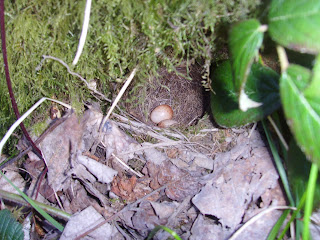First the good news. Out of all the boxes checked a total of 10 had eggs in them. No adult birds were seen during the visit and the eggs were all cold and unattended which is the norm before the entire clutch has been laid. Number of eggs ranged from 2 to 6, so there is obviously time for the birds to lay more eggs. All the eggs seen today looked like Blue or Great Tit eggs.
First eggs
As well as checking the nest boxes I also stumbled (literally) on this nest containing 3 eggs.
Wren's nest?
As I walked past it, a tiny, brown bird flew out and disappeared. My initial thought was Wren, especially as the nest was located on the floor under the roots of a tree. I moved away quickly, but I didn't see the adult bird again. When I checked in my nest guide book the eggs looked right for Wren, but the nest should have been lined with feathers. Apparently though the male bird will build several "cock's nests" and the female chooses one and lines it herself. Perhaps she's started laying and will line it later? That's the joy of nest finding - there's always something new to learn. I'll return next week to see if it's still there and to see if it's been lined. Meanwhile I'll start a new nest card for the BTO's Nest Record Scheme.
As I said at the start of the post there was good and bad news today. More good news was that the Mistle Thush was still sitting tight on its nest, the Great Crested Grebes have started building again, now that the water level has risen again, but unfortuntaely the Song Thrush nest I found a few weeks ago has failed. I checked it ealier this week and it contained 1 egg, but today it was empty and the adult bird was nowhere to be seen - presumably predated!
Song Thrush nest with 1 egg
Away from the eggs and nests I also managed to spot a few birds! The highlights today were my first Swallow, Sand Martin and Willow Warbler at Linacre this year. There were about a dozen Swallows flying low over the top reservoir with just 2 Sand Martins in amongst them. I'm particularly pleased with them as they are my first here since 2006! A Curlew was also heard, my second record of the year, and a pair of Grey Wagtails were present on the top reservoir. Last but by no means least was the small party of Lesser Redpoll in the Larch trees, the singing Blackcap (at least 3 around the reservoirs) and the 2 calling Green Woodpeckers, again my first here since 2010.




Hi there mate, the nest you think is a wrens , is in fact a robins nest, wrens build a domed nest ussually out of moss and straw, and then materials surrounding the nest to camouflage it.
ReplyDeleteIn addition, a wrens egg is pinkish with brown speckles and measures around 3.5 - 4mm in size, if this were a wren, you wouldn't be able to see the eggs.
And finally, robins also like to nest under tree roots, and they build a cup nest, as you see above, and the eggs there are conclusive of a robin
Hope I helped
Hi Dominic,
DeleteThanks a lot for the information. As you can see this was my first nest at Linacre and I subsequently went on to ring the chicks later in the season.
Are you a nest recorder? If not, it would be worth looking at the BTO's nest recording scheme www.bto.org/volunteer-surveys/nrs.
Cheers, Peter
Yes mate I am, I spend as much time as I can checking for nests, further to your recent post, drawing a comparison from last year's egg timings, I have also noticed the same sort of pattern, with most birds only just starting to pair up, and the tits which are normally investigating potential nest sites in early - mid march, only just beginning to.
ReplyDeleteI can only assume that this year's long winter has delayed the breeding season. May lead to some fierce battles for nesting sites as Migrants arrive, keep me posted on the developments on your local patch, would be good to draw some comparison from different areas of the country.
Hi again,
DeleteChecked the tit boxes again today and still no activity! See the most recent post for our Mandarin and Little Owl successes- very pleased! I'm part of the Sorby Breck Ringing Group (in my second year as a trainee) and we fill in nest record cards for all the nests we find.
Where abouts in the country are you?
I'm down in staffordshire, around the stoke on tent area, I don't ring mind, the birds are all pairing now but I've only found one breeding attempt so far and that was a long tailed tit, a single egg
ReplyDeleteBut the tits are all starting to gather nest materials, so hopefully a few more successful ones.
Your news on the owls is good, havent seen any owlets of yet, but im hopeful.
Any lapwing colonies near you?
Unfortunately we don't have any Lapwings at Linacre, although they do breed up on the moorland edges around Beeley Moor.
DeleteI've had a lot of singing birds on site recently, including Blackcap, Willow Warbler and Chiffchaff. I must try and find these nests this year. If only there were a few more hours in the day!
For will warblers and blackcaps try brambles with surrounding green vegetation, step slowly, if the nest is occupied the bird will not fly off until you are within 2/3 yards of the nest site , you probably already know but these birds rarely nest above 1m above ground level
DeleteMind you I bet you already knew that, I found a willow warbler last year but it was predated by a Fox id say, by the track markings
ReplyDelete